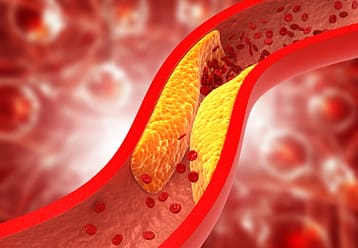Most people probably know that it’s possible to take “pictures” of the arteries in your neck to see if you have clogged arteries by doing an ultrasound. This test is done if the exam of your neck artery is abnormal, if you’ve had a stroke from a blood clot or had a TIA (transient mini stroke) because the carotid artery is a frequent source of the problem.

Carotid arteries can become diseased with the development of something called plaque, also called “hardening of the arteries.” It’s called hardening because as plaque evolves in the artery wall it gets more calcified, which makes it hard. When there is a buildup of plaque in the wall of the artery and it gets bad enough, it can actually interfere with the blood flow.
During an exam, a doctor can hear a swishing sound with each heartbeat showing there is turbulence in the flow caused by the plaque. That sound is called a bruit (pronounced “brew’-ee”). Now by the time you can hear a bruit in the carotid artery, the disease is already pretty far along and a stroke could happen anytime. So when a carotid bruit is heard on a routine exam, the usual next step is to get a carotid artery ultrasound to see how much plaque and obstruction there is. If obstruction is severe enough, surgery called a carotid endarterectomy, and informally known as roto-router, is performed to lower your risk of stroke. Or they may decide to do a balloon angioplasty and a place a stent.
Wouldn’t it be better to detect artery disease before you get to the point of needing surgery?
The latest technology for detecting artery disease BEFORE you get plaque buildup and are at risk of a stroke is called carotid intimal-media thickness test or CIMT.
CIMT uses high resolution ultrasound to see if there is plaque and obstruction and it measures how THICK the artery wall is. The thickness of the artery wall is directly related to the health of the artery and is a reflection of the physiological “age” of the artery.
This test is convenient in that it can be done right in a doctor’s office and it only takes 15 minutes to perform. You can actually watch the computer screen while the sonographer is doing the test standing behind you. You sit in a chair, in your street clothes, wearing a shirt you can unbutton so they can move the probe over your neck arteries. You can literally see your arteries in real time and see where you have any problems. Then you get a full patient-friendly printout in 2-3 weeks explaining everything that was found.

If abnormal changes are found indicating that you have some arterial disease, you can improve your situation over time with lifestyle medicine and if necessary, drugs that lower inflammation and put all of your metabolic risk factors into optimal ranges.
I think that an important outcome of this test is that by actually seeing that you HAVE arterial disease, you automatically become more highly motivated to take action steps to improve your situation. It’s easier to be motivated when you actually SEE you have the disease as opposed to my simply telling you that you are at RISK for arterial disease.
The test is typically under $250, and may be billable to insurance. A small price to pay I’d say to see if your arteries are healthy, especially since vascular disease is the #1 killer of Americans today.
For more information on the prevention, testing and treatments for vascular disease, call us today.


